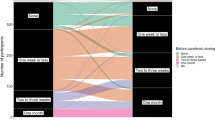Abstract
Despite being considered both the most effective treatment for beroin addiction and an essential tool in the prevention of buman immunodeficiency virus (HIV), methadone maintenance (MM) is often held in low esteem by beroin addicts—even those in MM treatment. This survey examined current beliefs and attitudes about MM of patients at an inner-city clinic, and the personal experience and attitudes of these patients with this treatment. Consenting patients in a methadone clinic serving a poor population with high rates of human immunodeficiency virus infection were queried about their attitudes toward and beliefs about methadone using a 16-item questionnaire. Over 2 days, 315 questionnaires were completed (acceptance rate 40%), totaling 32% of the 1000 clinic patients. Nearly 80% believed that methadone bad a positive effect on bis or ber life, but 80% were certain or unsure as to whether methadone is bad for one's bealth, and a similar percentage (80%) believed that discontinuing methadone was an important goal. Patients continue to have strongly negative attitudes toward and beliefs about methadone despite their acknowledgement that methadone has been very positive for them as individuals. As a result, many patients leave MM treatment prematurely, and there are usually unfilled slots in MM programs in New York City, even while continued need exists (e.g., less than 25% of the beroin addicts in the city are in treatment). The restrictive nature of many MM programs may account for these attitudes and beliefs.
Similar content being viewed by others
References
National Institutes of Health. Effective medical treatment of opiate addiction. NIH Consensus Statement Online 1997 November 17–19;15(6):1–38. Available at: http://odp.od.nih.gov/consensus/cons/108/108-statement.htm#3. Date accessed: April 22, 2002.
Drucker E, Lurie P, Wodak A, Alcabes P. Measuring harm reduction: the effects of needle and syringe exchange programs and methadone maintenance on the ecology of HIV. AIDS. 1998;12(suppl A):S217-S230.
Metzger DS, Navaline H, Woody GE: Drug abuse treatment as AIDS prevention. Public Health Rep. 1998;113(suppl 1):97–106.
Caplehorn JR, Dalton MS, Cluff MC, Petrenas AM. Retention in methadone maintenance and heroin addicts' risk of death. Addiction. 1994;89:203–209.
Laine C, Markson LE, McKee LJ, Hauck WW, Fanning TR, Turner BJ. The relationship of clinic experience with advanced HIV and survival of women with AIDS. AIDS. 1998; 12:417–424.
Newschaffer CJ, Laine C, Hauck WW, Fanning T, Turner BJ. Clinic characteristics associated with reduced hospitalization of drug users with AIDS. J Urban Health. 1998; 75:153–169.
Centers for Disease Control and Prevention. {jtHIV/AIDS Surveill Rep.} {dy2000};{vn12}({sn1}).
Bureau of HIV/AIDS Epidemiology, New York State Department of Health. AIDS Surveillance Quarterly Update: Cases Reported Through June, 2000. Albany, NY: New York State Department of Health; 2000.
Opioid Drugs in Maintenance and Detoxification Treatment of Opiate Addiction; Final Rule. Substance Abuse and Mental Health Services Administration. 66 (11) Federal Register (Wednesday, January 17, 2001), Rules and Regulations.
Goldsmith DS, Hunt DE, Lipton DS, Strug DL. Methadone folklore: beliefs about side effects and their impact on treatment. Hum Organ. 1984;43:330–340.
Hunt DE, Lipton DS, Goldsmith DS, Strug DL, Spunt B. “It takes your heart”: the image of methadone maintenance in the addict world and its effect on recruitment into treatment. Int J Addict. 1985;20:1751–1771.
Rosenblum A, Magura S, Joseph H. Ambivalence toward methadone treatment among intravenous drug users. J Psychoactive Drugs. 1991;23:21–27.
Murphy S, Irwin J. “Living with the dirty secret”: problems of disclosure for methadone maintenance clients. J Psychoactive Drugs. 1992;24:257–264.
Zule WA, Desmond DP. Attitudes toward methadone maintenance: implications for HIV prevention. J Psychoactive Drugs. 1998;30:89–97.
D'Aunno T, Folz-Murphy N, Lin X. Changes in methadone treatment practices: results from a panel study, 1988–1995. Am J Drug Alcohol Abuse. 1999;25:681–699.
New York State Department of Health, AIDS Institute. Community Need Index for New York City HSA Region. Albany, NY: New York State Department of Health; 1995.
Rhoades HM, Creson D, Elk R, Schmitz J, Grabowski J. Retention, HIV risk, and illic drug use during treatment: methadone dose and visit frequency. Am J Public Health. 1998;88:34–39.
Rettig RA, Yarmolinsky A, eds. Federal Regulation of Methadone Treatment. Washington, DC: National Academy Press; 1995.
Narcotics Anonymous. World Services Regarding Methadone and Other Drug Replacement Programs. World Service Board of Trustees. Bulletin 29. Available at: www.na.org/bull29. htm. Date accessed: April 22, 2002.
Koch M, Banys P. Liver transplantation and opioid dependence. JAMA. 2001;285: 1056–1058.
Caplehorn JR, Irwig L, Saunders JB. Attitudes and beliefs of staffworking in methadone maintenance clinics. Subst Use Misuse. 1996;31:437–452.
Caplehorn JR, Hartel DM, Irwig L. Measuring and comparing the attitudes and beliefs of staff working in New York methadone maintenance clinics. Subst Use Misuse. 1997; 32:399–413.
Magura S, Rosenblum A. Leaving methadone treatment: lessons learned, lessons forgotten, lessons ignored. Mt Sinai J Med. 2001;68:62–74.
Frank B. An overview of heroin trends in New York City; past, present and future. Mt Sinai J Med. 2000;67:340–346.
Author information
Authors and Affiliations
Corresponding author
Additional information
Weill Medical College of Cornell University; and Dr. Drucker is with Montefiore Medical Center/Albert Einstein College of Medicine.
Rights and permissions
About this article
Cite this article
Stancliff, S., Elana Myers, J., Steiner, S. et al. Beliefs about methadone in an inner-city methadone clinic. J Urban Health 79, 571–578 (2002). https://doi.org/10.1093/jurban/79.4.571
Published:
Issue Date:
DOI: https://doi.org/10.1093/jurban/79.4.571




